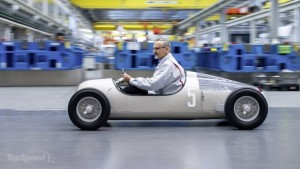Audi, however, has embraced 3D printing to the extent that it’s now investigating the process behind the 3D printing of metal objects. To illustrate how far along Audi has come in this development, the company has successfully created a 1:2 scale of the legendary 1936 Auto Union Type C race  car.
car.
The creation of the scaled Auto Union Type C comes by way of Audi Toolmaking, an in-house division that’s largely responsible for the development of new technologies. Whereas other companies have managed to successfully use 3D printing on a small scale – Koenigsegg, for instance, was able to use the technology in the development of the One:1 megacar – Audi is trying to use the same technology and apply it on a bigger scale. The 1:2 scale example of the Auto Union Typ C is the biggest example it can build at this point since the printer can only construct parts that measure up to 9.5 inches long and 7.9 inches wide. In other words, it still can’t print materials that can be used in the actual manufacturing of our cars.
The know-how is already there, as is the precedent since 3D printing using plastic and in some cases, carbon fiber, has already been achieved. The short and presumably long-term goal for Audi Toolmaking is to be able to complete that same process using metals instead. Doing so would have immeasurable benefits for the company, as it could cut the production time of a number of integral parts to its cars, thus speeding up the assembly process.
The company is showcasing the 1:2 scale of the Auto Union Typ C to show how far it’s come in this technological pursuit with the hopes of one day building something that’s true-to-scale.
Press Release
From powder to a component: With a 3D printer, Audi Toolmaking has produced a model of the historical Grand Prix sports car “Auto Union Typ C” from the year 1936. The company is now examining further possible applications of metal printers for the production of complex components. At the same time, Audi is creating important synergies with toolmaking in other parts of the Volkswagen Group.
“We are pushing forward with new manufacturing technologies at Audi Toolmaking and at the Volkswagen Group,” stated Prof. Dr. Hubert Waltl, Audi’s Board of Management Member for Production and Head of Toolmaking at the Volkswagen Group. “Together with partners in the area of research, we are constantly exploring the boundaries of new processes. One of our goals is to apply metal printers in series production.”
The Volkswagen Group has a total of 14 toolmaking units in nine countries. Under the leadership of Prof. Dr. Waltl, cooperative ventures have been arranged for research and development. The first focus of the cooperation is the implementation of metallic 3D printing and 3D printing in the sand‑printing method. Audi Toolmaking has now used metal printing to produce all the metallic parts of the Silver Arrow model “Auto Union Typ C” on a scale of 1:2.
For this purpose, a selective-sintering laser melted layers of metallic powder with a grain size of 15 to 40 thousandths of a millimeter, roughly half of the diameter of a human hair. The process therefore allows the production of components with complex geometries, which with conventional methods could either not be produced or only with great difficulties. Audi Toolmaking is currently using 3D printing to produce components out of aluminum and steel. At present, this process can be used to produce shapes and objects with a length of 240 millimeters and a height of up to 200 millimeters. These printed components achieved a higher density than components made by die casting or hot forming.
Audi Toolmaking is regarded as a pioneer in the development of new technologies, also within the Volkswagen Group. The company’s innovations include the intelligent tool, which is used to help make more sharper contours in the sheet metal of car bodies. Lasers installed in the tool measure the position of the sheet metal while activators take corrective action.
